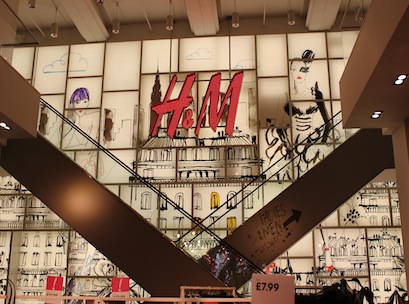H&M, short for Hennes & Mauritz, is the world’s second-biggest clothing retailer by sales. The opening of H&M’s Melbourne store last year attracted more than 15,000 customers on its first day of trade and generated more than $65 million in sales in the first seven months from this single store alone.
With H&M set to open their second Sydney store in the CBD later this month, what is it about this Swedish fashion brand which draws these huge crowds?
What is it about this omni fashion retail juggernaut, playing the game of fashion globally, across brand, community, influence and affluence?
There is no doubt about it; the fast fashion retailers of Europe are making a big impact on the Australian high street. H&M and its international peers such as Zara and Forever 21, offer a continuous supply of fresh and inspiring clothes at extremely low prices, therefore capturing the hearts and minds of thousands of Australian consumers.
Culminating in market share akin to somewhere between 12-15 billion, our neighbours open a door that previously remained unopened, and H&M are strongly representative of a model for which product is really only a relatively modest part of the story.
Their fast fashion models involve continuously identifying new fashion trends, and then designing and manufacturing accordingly at a fast speed and low cost, to ensure mainstream consumers can buy these items as soon as possible. Utilising technology to speed up communication in the design process, and keeping a clean, nimble supply chain and sophisticated inventory monitoring and management system, these stores are tracking real time sales data in order to dramatically reduce risk and lead time.
Navigating consumers to repeatedly visit the same store many times in one season, they have eliminated the customer’s frustrations of continuously searching for a bargain, and created go-to locations for high fashion pieces at bargain prices.
Secondly, H&M’s success within the digital realm. According to data from Social Bakers the brand has received the most engagement on Facebook compared with American Apparel, Gap, J.Crew and even Zara. Similarly it boasts the highest number of interactions with customers on Instagram. H&M skilfully uses these platforms within their retail strategy as inspiration platforms for their customers, creating a strong relationship with their community of followers, but also to get closer and gather insights towards creating more relevant products going forward.
Another area of strength for this retailer is it’s unique and sought after collaborations. Whilst the products may be cheap H&M’s infamous collaborations with renowned designers, models and celebrities such as Alexander Wang and Versace not only heighten brand awareness but dramatically increase brand value. Partnerships with well-known bloggers who hype the brand to their readers, also assists in a more premium perception of the brand driving demand for their limited high fashion pieces at slightly higher price points.
So, as an independent Australian retailer, how do you compete?
While this fast fashion model is successful, it does not appeal to all and initiating a digital strategy should be a consideration for all retailers in today’s omnichannel environment. There are several ways ‘fit’ independent retailers can not only compete but keep front of mind for many consumers.
- Be unique; your brand, store experience and product. Be proud of who you are and don’t try to adapt to fast fashion if this is not a natural fit for your business.
- Sell your brand values and culture by engaging your customers in instore events to build loyalty and sense of community.
- Be aware of your customer journey to your brand. From their social journey via some media and online, to their physical journey, the environments they live and work in, and target your marketing efforts accordingly.
- Inspire by curating merchandise assortments. Many customers do not like too much choice, so providing inspirational product assortments not only will attract these customers, but will also help in upselling.
- Keep these merchandise assortments fresh. You may not have new product every week like fast fashion retailers, but with strong visual merchandising you can keep your windows and mannequins looking fresh and desirable to spark the interest of your returning customer.
- Store experience. One thing many fast fashion retailers lack is personalised customer service due to the focus being on speed and efficiency. Offering high level customer service will help you stand out from the crowd.
Ultimately fast fashion is creating a highly diverse and exciting future for the Australian fashion industry.
We look forward to seeing what the new H&M flagship store, opening at the end of October, has to bring.
Brian Walker is Founder and CEO of Retail Doctor Group and can be contacted on (02) 9460 2882 or brian@retaildoctor.com.au.






